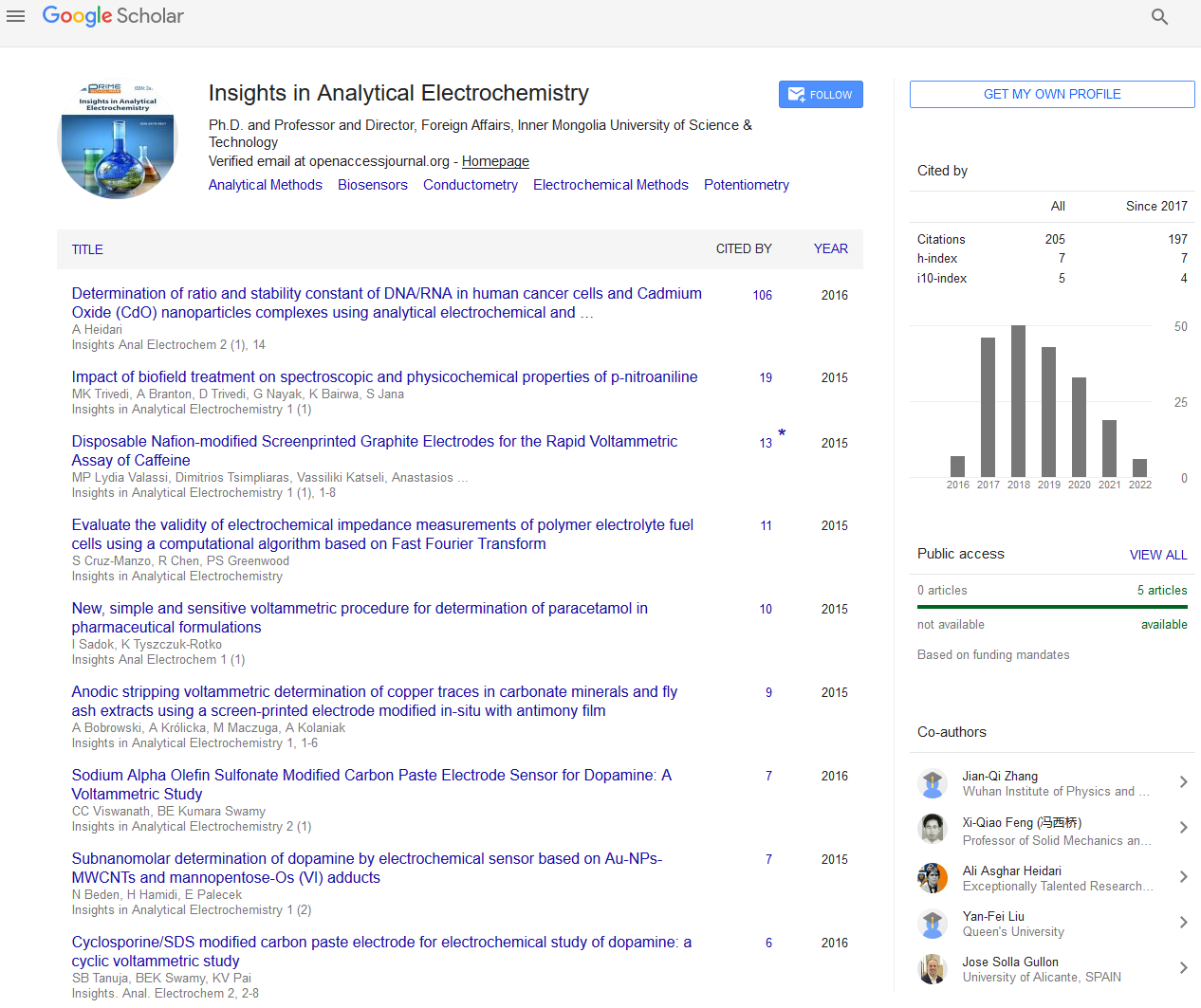Opinion - (2022) Volume 8, Issue 5
Brief Note on Revolutionary New Bioengineering Technology
Mario Gonzalez*
Department of Chemistry, Sao Paulo State University, Brazil
*Correspondence:
Mario Gonzalez,
Department of Chemistry, Sao Paulo State University,
Brazil,
Email:
Received: 31-Aug-2022, Manuscript No. IPAEI-22-14742;
Editor assigned: 02-Sep-2022, Pre QC No. IPAEI-22-14742(PQ);
Reviewed: 16-Sep-2022, QC No. IPAEI-22-14742;
Revised: 21-Sep-2022, Manuscript No. IPAEI-22-14742(R);
Published:
28-Sep-2022, DOI: 10.21767/2470-9867.22.8.24
INTRODUCTION
For fundamental studies of single-cell neuronal communication,
chemical messenger molecule release and reuptake,
cellular imaging, and small-scale electroporation applications,
electrochemistry in ultra-small environments has grown in importance.
Through the writings of Galvani and then Alessandro
Volta, the beginnings of bioelectrochemistry and electrochemistry
are closely associated with physiology. The German physiologist
Julius Bernstein’s 1902 study of the source of bio potentials
caused by different ion concentrations passing through
the cell wall is considered to be the first modern work in this
field. Over the past century, the sector of bioelectrochemistry
has expanded significantly while maintaining close ties to a
number of medical, biological, and engineering fields like electrophysiology,
biomedical engineering, and enzyme kinetics.
Numerous Nobel Prizes in Physiology or Medicine are given
for these achievements. The revolutionary new bioengineering
technology referred to as bio electrochemical systems combine
the electrochemical method with microorganisms or enzymes
to enhance the reducing or oxidizing metabolism.
Description
Bio-electro-chemistry is an interdisciplinary field that straddles
the fields of biochemistry, analytical chemistry, medicinal
chemistry, bio-energy devices, and biosensors additionally to
basic electrochemistry. The topic has numerous applications
and a broad scope. However the elemental principles are the
electrochemical laws. Biosensors, biofuel cells, and diagnostics
are just some of the many applications of electrochemistry’s
fundamental principles that we will discuss in this section. Bio
electrochemical systems typically depict the processes involved
in producing electric power or achieving the reducing reaction
with a particular potential poised through the transfer of elecelectrons
between the electron acceptor and electron donor. The
design of electrochemical devices, the choice and optimization
of electrode materials, and therefore the screening of electrochemically
active or inactive model microorganisms have all
been areas of focus for researchers. Notably, all of those methods
and studies are connected to electron transfer consumption
and expulsion. Thus, we elaborate on the extracellular and
intracellular electron transfer, also as the speculative electron
transfer mechanism, and present the elemental ideas of bio
electrochemical systems. Coenzyme metabolism, intracellular
energy production, and electron transfer also are examined.
Finally, we speak about the potential of microbial electrochemical
technologies and the applications of bio-electrochemical
systems. Nanowires, electron shuttles, and modified electrodes
all aim to hurry up extracellular electron transfer and strengthen
the relationship between electrodes and cells. A number of
electron or proton carriers, like cytochromes, ubiquinone, and
various oxido-reductases, structure the intracellular electron
transfer chain (ETC, also referred to as the respiratory chain).
Along with the synthesis of ATP; electrons are moved within
the ETC from a high potential electron donor to a coffee potential
electron acceptor.
Conclusion
Biomedical alloys may undergo increased oxygen and water
molecule reduction as results of potentials shifting catholically
across the metal-oxide-electrolyte interface during tribocorrosion.
Hydroxide ions and Reactive Oxygen Species (ROS) are
thought to be the byproducts of reduction. ROS generation at
catholically biased alloy surfaces was directly measured with
fluorescent probes developed for labelling intracellular ROSbased
hydroxyl radicals (OH) and peroxide (H2O2). Bio electrochemical
systems are unique systems capable of converting the
chemical energy of organic waste including low-strength waste waters and lignocellulose biomass into electricity or hydrogen/
chemical products in microbial fuel cells (MFCs) or microbial
electrolysis cells respectively, or other products formed at the
cathode by an electrochemical reduction process. As compared
to conventional fuel cells, BESs operate under relatively mild
conditions, use a wide variety of organic substrates and mostly
do not use expensive precious metals as catalysts.
Acknowledgement
None.
Conflict of Interest
The author’s declared that they have no conflict of interest.
Citation: Gonzalez M (2022) Brief Note on Revolutionary New Bioengineering Technology. Insights Anal Electrochem. 8:24.
Copyright: © 2022 Gonzalez M. This is an open-access article distributed under the terms of the Creative Commons Attribution
License, which permits unrestricted use, distribution, and reproduction in any medium, provided the original author and source
are credited.

